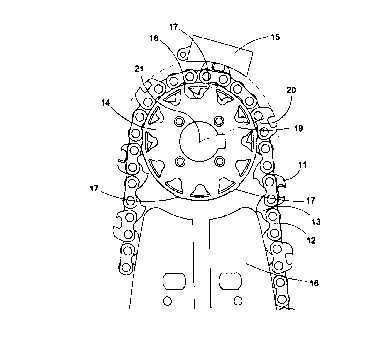Some of the information on this Web page has been provided by external sources. The Government of Canada is not responsible for the accuracy, reliability or currency of the information supplied by external sources. Users wishing to rely upon this information should consult directly with the source of the information. Content provided by external sources is not subject to official languages, privacy and accessibility requirements.
Any discrepancies in the text and image of the Claims and Abstract are due to differing posting times. Text of the Claims and Abstract are posted:
| (12) Patent Application: | (11) CA 2295758 |
|---|---|
| (54) English Title: | GRINDING DEVICE FOR CHAIN SAWS |
| (54) French Title: | DISPOSITIF D'AFFUTAGE DE SCIES A CHAINE |
| Status: | Deemed Abandoned and Beyond the Period of Reinstatement - Pending Response to Notice of Disregarded Communication |
| (51) International Patent Classification (IPC): |
|
|---|---|
| (72) Inventors : |
|
| (73) Owners : |
|
| (71) Applicants : |
|
| (74) Agent: | GOWLING WLG (CANADA) LLP |
| (74) Associate agent: | |
| (45) Issued: | |
| (86) PCT Filing Date: | 1998-06-17 |
| (87) Open to Public Inspection: | 1999-01-07 |
| Availability of licence: | N/A |
| Dedicated to the Public: | N/A |
| (25) Language of filing: | English |
| Patent Cooperation Treaty (PCT): | Yes |
|---|---|
| (86) PCT Filing Number: | PCT/SE1998/001176 |
| (87) International Publication Number: | SE1998001176 |
| (85) National Entry: | 1999-12-23 |
| (30) Application Priority Data: | ||||||
|---|---|---|---|---|---|---|
|
Grinding device for chain saws, where the saw chain is sharpened b pressing an
abrasive block (15) against the top side of the cutter links (11) when the saw
chain is running around a rim type sprocket (14) and the generally cylindrical
periphery of the drive sprocket has raised steps or ramps (17, 27) which lift
the front end of the cutter links, thereby allowing a sufficiently large
cutting depth without locating the depth gauge far in front of the front
rivet. This reduces vibrations and instabilities of the saw chain when sawing.
L'invention concerne un dispositif d'affûtage de scies à chaîne. La chaîne est aiguisée par application d'un bloc abrasif (15) sur la face supérieure des maillons coupants (11) lorsque la chaîne défile autour d'une roue dentée de type jante (14). La périphérie généralement cylindrique de la roue d'entraînement possède des dents ou dents en biseau (17, 27) qui soulèvent l'extrémité frontale des maillons coupants (11). On obtient ainsi une profondeur de coupe suffisamment importante sans qu'il faille placer la cale étalon de profondeur loin devant le rivet frontal. Cela permet de réduire les vibrations et les instabilités de la chaîne lors du sciage.
Note: Claims are shown in the official language in which they were submitted.
Note: Descriptions are shown in the official language in which they were submitted.

2024-08-01:As part of the Next Generation Patents (NGP) transition, the Canadian Patents Database (CPD) now contains a more detailed Event History, which replicates the Event Log of our new back-office solution.
Please note that "Inactive:" events refers to events no longer in use in our new back-office solution.
For a clearer understanding of the status of the application/patent presented on this page, the site Disclaimer , as well as the definitions for Patent , Event History , Maintenance Fee and Payment History should be consulted.
| Description | Date |
|---|---|
| Application Not Reinstated by Deadline | 2003-06-17 |
| Time Limit for Reversal Expired | 2003-06-17 |
| Deemed Abandoned - Failure to Respond to Maintenance Fee Notice | 2002-06-17 |
| Inactive: Cover page published | 2000-03-03 |
| Inactive: First IPC assigned | 2000-03-02 |
| Letter Sent | 2000-02-22 |
| Inactive: Notice - National entry - No RFE | 2000-02-17 |
| Application Received - PCT | 2000-02-11 |
| Application Published (Open to Public Inspection) | 1999-01-07 |
| Abandonment Date | Reason | Reinstatement Date |
|---|---|---|
| 2002-06-17 |
The last payment was received on 2001-06-18
Note : If the full payment has not been received on or before the date indicated, a further fee may be required which may be one of the following
Patent fees are adjusted on the 1st of January every year. The amounts above are the current amounts if received by December 31 of the current year.
Please refer to the CIPO
Patent Fees
web page to see all current fee amounts.
| Fee Type | Anniversary Year | Due Date | Paid Date |
|---|---|---|---|
| Registration of a document | 1999-12-23 | ||
| Basic national fee - standard | 1999-12-23 | ||
| MF (application, 2nd anniv.) - standard | 02 | 2000-06-19 | 2000-05-25 |
| MF (application, 3rd anniv.) - standard | 03 | 2001-06-18 | 2001-06-18 |
Note: Records showing the ownership history in alphabetical order.
| Current Owners on Record |
|---|
| KAPMAN AB |
| Past Owners on Record |
|---|
| PER-OLOF LOFGREN |